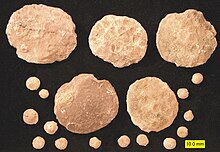| Nummulite Temporal range:
| |
|---|---|

| |
| Fossil nummulitid foraminiferans showing microspheric and megalospheric individuals; Eocene of the United Arab Emirates; scale in mm. | |
| Scientific classification | |
| Domain: | Eukaryota |
| Clade: | Diaphoretickes |
| Clade: | SAR |
| Phylum: | Retaria |
| Subphylum: | Foraminifera |
| Class: | Globothalamea |
| Order: | Rotaliida |
| Family: | Nummulitidae |
| Genus: | Nummulites Lamarck, 1801 |
| Species | |
|
Numerous | |
A nummulite is a large lenticular fossil, characterised by its numerous coils,[1] subdivided by septa into chambers. They are the shells of the fossil and present-day marine protozoan Nummulites, a type of foraminiferan. Nummulites commonly vary in diameter from 1.3 cm (0.5 inches) to 5 cm (2 inches)[2] and are common in Eocene to Miocene marine rocks, particularly around southwest Asia and the Mediterranean in the area that once constituted the Tethys Ocean, such as Eocene limestones from Egypt[3] or from Pakistan.[4] Fossils up to six inches wide are found in the Middle Eocene rocks of Turkey.[5] They are valuable as index fossils.
The ancient Egyptians used nummulite shells as coins and the pyramids were constructed using limestone that contained nummulites.[3][6] It is not surprising then that the name Nummulites is a diminutive form of the Latin nummulus 'little coin', a reference to their shape.[7]
In 1913, naturalist Randolph Kirkpatrick published a book, The Nummulosphere: an account of the Organic Origin of so-called Igneous Rocks and Abyssal Red Clays, proposing the unconventional theory that all rocks had been produced through the accumulation of forams such as Nummulites.
- ^ 'Nummulite', Tiscali Dictionary of Animals, retrieved 17 August 2004
- ^ Isquirth, Irwin Richard (2011). In The World Book Encyclopedia. print.
- ^ a b Kaplan, Sarah, Brilliance without a brain Archived 2018-03-08 at the Wayback Machine, Speaking of Science, The Washington Post, March 7, 2018
- ^ Banerjee, Santanu; Khanolkar, Sonal; Saraswati, Pratul Kumar (23 February 2018). "Facies and depositional settings of the Middle Eocene-Oligocene carbonates in Kutch". Geodinamica Acta. 30 (1): 119–136. Bibcode:2018GeoAc..30..119B. doi:10.1080/09853111.2018.1442609.
- ^ 'Biggest Microbes', Guinness World Records 2001, p. 153.
- ^ Isquirth, Irwin Richard (2011). In The World Book Encyclopedia. print.
- ^ Hottinger, Lukas (2006-09-08). "Illustrated glossary of terms used in foraminiferal research". Paleopolis. Archived from the original on 2012-06-21. Retrieved 2018-11-11.